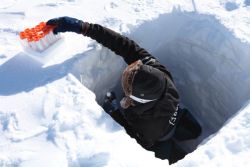Talking about their scientific projects
Published on 15.01.2012 - Acciona Windpower Antarctica 90°S
While the zero emission vehicle is progressing towards Union Glacier ALE base camp, Juan Pablo Albar, the biochemistry scientist, is describing the scientific projects the expedition is involved in.
In fact, Ramón Larramendi's expedition is involved in three major scientific projects :
- The project they’re carrying out for the CNRS and the J. Fourier University of Grenoble to determine the oxygen (O18/O16) and hydrogen (D/H) ratios in snow samples taken between Novo and the South Pole (34) and then vertically around the same point. This project has counted on the invaluable cooperation of Javier Selva whose enthusiasm has helped to optimize the sampling process which calls for the titanized canister being dropped onto the snow’s surface (the canister is white in color, like the snow it is in contact with), applying pressure to the canister to fill it with 100 x 6 cm of compacted snow, extracting the snow later and homogenizing it, and then dividing it in equal parts in a number of labeled 50ml polyethylene tubes before storing it at environment temperature (ranging between -25ºC and -38ºC) in less than five minutes.
- Sampling of the air along their crossing, as part of the project for CSIC (IDAEA-CSIC) Barcelona. This project sets out to take samples of air on the Antarctic Plateau to detect the possible presence of Persistent Organic Pollutants (POP for short) caused by industrial activity during, primarily, the second half of the 20th century. POPs are chemical compounds which are virtually or even completely undegradable; they accumulate in living systems and are harmful to humans and fauna. POPs include organo-polyhalogenated biphenyls (mainly chlorates) and pesticides such as DDT.
- Finally, there’s the project for Madrid’s Universidad Autónoma (led by Profs. A. Quesada and D. Velazquez), for which they have taken samples of roughly one-and-a-half kilos of quasi-sterile snow from a number of locations, the last one being near the South Pole. This project sets out to ascertain if the selected samples are sufficient to obtain high-sensitivity and precision spectrometer readings of mass and detect the presence of compounds, such as Dissolved Organic Carbon (DOC for short), that point to remains of some kind of life activity.
Besides, Ramón Larramendi takes the time to describe in details the daily life on board this zero emission vehicle, the way they rest while the other are manoeuvring/kiting the sledge, what they eat (they have by far too much food because the lack of appetite since the deprture on the Plateau), what they do, how long does it take to change kites, etc.
Since they left the Pole they have had good conditions and have covered already 2,5 degreees in latitude (about 285 kil). But on the 13 January, they had no more wind. They have 600 kil to go.











